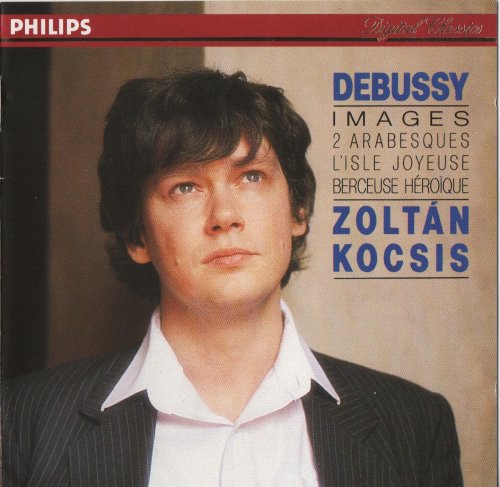
Zoltán Kocsis - Debussy: Images, 2 Arabesques, L'Isle Joyeuse (1990)
BAND/ARTIST: Zoltán Kocsis
- Title: Debussy: Images, 2 Arabesques, L'Isle Joyeuse
- Year Of Release: 1990
- Label: Philips
- Genre: Classical
- Quality: FLAC (image+.cue,log,scans)
- Total Time: 01:02:11
- Total Size: 203 Mb
- WebSite: Album Preview
Tracklist:
01. Images, Livre 1: 1. Reflets dans l'eau [0:05:28.00]
02. Images, Livre 1: 2. Hommage a Rameau [0:08:22.00]
03. Images, Livre 1: . Mouvement [0:03:17.00]
04. Images Livre 2: 1. Cloches a travers les feuilles [0:04:13.00]
05. Images Livre 2: 2. Et la lune descend sur le temple qui fut [0:06:11.00]
06. Images Livre 2: 3. Poissons d'or [0:04:05.00]
07. D'un cahier d'esquisses [0:04:53.00]
08. L'Isle joyeuse [0:06:12.00]
09. Arabesque no 1 [0:03:56.00]
10. Arabesque no 2 [0:02:56.00]
11. Hommage a Haydn [0:02:28.00]
12. Reverie [0:03:58.00]
13. Page d'album [0:01:02.00]
14. Berceuse heroique [0:05:11.00]
Performers:
Zoltán Kocsis – piano
01. Images, Livre 1: 1. Reflets dans l'eau [0:05:28.00]
02. Images, Livre 1: 2. Hommage a Rameau [0:08:22.00]
03. Images, Livre 1: . Mouvement [0:03:17.00]
04. Images Livre 2: 1. Cloches a travers les feuilles [0:04:13.00]
05. Images Livre 2: 2. Et la lune descend sur le temple qui fut [0:06:11.00]
06. Images Livre 2: 3. Poissons d'or [0:04:05.00]
07. D'un cahier d'esquisses [0:04:53.00]
08. L'Isle joyeuse [0:06:12.00]
09. Arabesque no 1 [0:03:56.00]
10. Arabesque no 2 [0:02:56.00]
11. Hommage a Haydn [0:02:28.00]
12. Reverie [0:03:58.00]
13. Page d'album [0:01:02.00]
14. Berceuse heroique [0:05:11.00]
Performers:
Zoltán Kocsis – piano
You can understand why this was an award-winning release in 1990, for Zoltan Kocsis is an instrumentalist who can make a piano do whatever he wants. Kocsis’ vibrant projection and singing tone empower the smaller Debussy works in a manner that refreshingly contrasts with more “traditional” impressionistic, cameo-like interpretations. By contrast, the pianist glides across L’Isle Joyeuse’s bacchanalian terrian via the scenic route, without a clear road map. Out of curiosity I pulled down Horowitz’s live 1966 Carnegie Hall version, and was pleasantly surprised by how the older pianist’s similar penchant for local color is anchored by stricter rhythm, sharper articulation, plus a clearer sense of where bass lines and inner counterpoints are moving.
Kocsis is at his best in Images Book 2. Although his basic tempo for Cloches à travers les feuilles is brisker than the “Lent” Debussy asks for, you can’t deny the pianist’s ravishing orchestration of the music’s interweaving textures. Poissons d’or gets a more aggressive, dynamically charged treatment than usual (as if the goldfish had been replaced by a piranha!), yet it also reveals the care with which Kocsis differentiates long and detached phrases.
Images Book 1 stands out for Kocsis’ strong, technically immaculate, and cannily proportioned Reflets dans l’eau. However, his dabs of rubato and occasional breaking of hands Paderewski-style dissipate Hommage à Rameau’s processional flow, stretching the music out to eight minutes. The opposite happens in Mouvement, where Kocsis sets a breakneck tempo that necessitates adjustment at inopportune moments (the climactic scales, for instance). Both Michelangeli and Aimard opt for a slower, rock-steady momentum that proves infinitely more effective. No doubt Kocsis fans will treasure this disc’s finest performances, but go to the pianist’s masterly Bartók and Rachmaninov CDs if you want to hear his best work.
Kocsis is at his best in Images Book 2. Although his basic tempo for Cloches à travers les feuilles is brisker than the “Lent” Debussy asks for, you can’t deny the pianist’s ravishing orchestration of the music’s interweaving textures. Poissons d’or gets a more aggressive, dynamically charged treatment than usual (as if the goldfish had been replaced by a piranha!), yet it also reveals the care with which Kocsis differentiates long and detached phrases.
Images Book 1 stands out for Kocsis’ strong, technically immaculate, and cannily proportioned Reflets dans l’eau. However, his dabs of rubato and occasional breaking of hands Paderewski-style dissipate Hommage à Rameau’s processional flow, stretching the music out to eight minutes. The opposite happens in Mouvement, where Kocsis sets a breakneck tempo that necessitates adjustment at inopportune moments (the climactic scales, for instance). Both Michelangeli and Aimard opt for a slower, rock-steady momentum that proves infinitely more effective. No doubt Kocsis fans will treasure this disc’s finest performances, but go to the pianist’s masterly Bartók and Rachmaninov CDs if you want to hear his best work.
DOWNLOAD FROM ISRA.CLOUD
Zoltan Kocsis Debussy Images 2 Arabesques LIsle Joyeuse 90 2110.rar - 203.6 MB
Zoltan Kocsis Debussy Images 2 Arabesques LIsle Joyeuse 90 2110.rar - 203.6 MB
Classical | FLAC / APE | CD-Rip
As a ISRA.CLOUD's PREMIUM member you will have the following benefits:
- Unlimited high speed downloads
- Download directly without waiting time
- Unlimited parallel downloads
- Support for download accelerators
- No advertising
- Resume broken downloads


